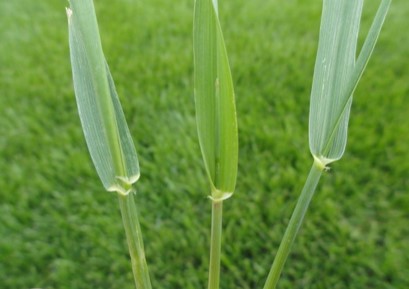
Weeds that affect home lawns are divided into two categories: broadleaves and grassy weeds. While there are some stubborn broadleaf weeds (creeping charlie and wild violets), they are largely the easier group to control. Their anatomy and the way they grow is much different than turfgrass, so scientists can more easily come up with chemistry to control them.
Grassy weeds are an entirely different story! Several grassy weeds are problematic in Cedar Rapids and Iowa City lawns, and a few of them simply can’t be controlled with selective herbicides (selective herbicides are safe on the grass we want to keep, while controlling weeds we want to eliminate). One of those is quackgrass. Let’s take a closer look!
Identification of Quackgrass
Quackgrass is very easy to mistake for a desirable grass like Kentucky bluegrass or ryegrass. After the lawn has been mowed, it’s nearly impossible to find. Since it tends to grow very fast, it usually sticks out a few days after mowing. The blades tend to grow more upright and stiff (like tall fescue, another grass we’ve discussed). Tall fescue leaves tend to be a darker green and wider, with tall fescue growing in clumps. Quackgrass does not grow in thick, dense fashion like bluegrass. When the leaves are visible, they are somewhat sparse in comparison to the turf around it. Here are a few pictures that do a good job showing this.

When looking at quackgrass up close, it has distinctive little “fingers” that we like to call auricles. These auricles are present where new growth emerges from the stem of the plant. The following picture shows these auricles “in the wild”.

Quackgrass grows in a wide variety of weather conditions, so don’t be surprised if you see it growing early in the spring before everything else wakes up. It can be frustrating to see it so early in the season, but this can be a positive in that we know where it is early in the season and can come up with a plan!
The single characteristic that makes quackgrass so difficult to control are its underground roots, called rhizomes. Quackgrass roots have been found at depths up to six feet! Rhizomes usually help plants grow a nice, dense cover as is the case with Kentucky bluegrass. In the case of quackgrass, rhizomes aid in helping it spread long distances.

These thick rhizomes are difficult to pull in their entirety, and if pieces are left behind, they can give rise to new plants. When quackgrass is treated with a non-selective herbicide like Round-Up, it’s difficult for the product to work all the way through this root system. If the rhizomes are deep enough, new growth won’t occur, but this plant tissue can lie dormant in the soil.
Controlling Quackgrass
Complete control of quackgrass is nearly impossible. The good news is that quackgrass can be suppressed to the point where it is a minor issue. Regular mowing and proper fertilization to keep the turf in good health will help “choke out” quackgrass. It isn’t completely gone, but it has a very hard time competing in a healthy patch of turf. We’re doing very well if quackgrass is suppressed to the point where it isn’t noticed!
Chemical control of quackgrass can be attempted with a non-selective herbicide like glyphosate (Round-Up). The technique we can use is like the method discussed in our blog post about tall fescue. When the leaf blades are longer than the turf around them, they can be brushed with a 2% Round-Up solution. If one wishes to try this, dipping a sponge in such a solution would reduce the likelihood of dripping some on accident. It’s important to note that this carries a great deal of risk and it isn’t something that we recommend. If something is accidentally spilled, that turf will be affected.
Quackgrass can also be an issue in landscaping beds. In that case, we can utilize a spray to ensure thorough coverage on the leaf tissue, with follow-up applications to achieve better control.

No comment yet, add your voice below!